Beginners are often stumped when it comes to training the upper chest without an inclining bench. You may not have the space, money, or commitment required to invest in a weight bench. But that’s fine! Because today I’ll be sharing 11 incline bench alternatives anyone can try at home.
I’ve included both incline weight bench alternatives as well as incline bench press exercise alternatives.
This will equip you with everything required to build a bigger and more defined upper chest at home without having to spend money on an incline bench!
Disclaimer: although I’ve personally tried all of these methods and deem them safe, please stay vigilant and take your own safety precautions. I would always recommend investing in a proper weight bench if you can.
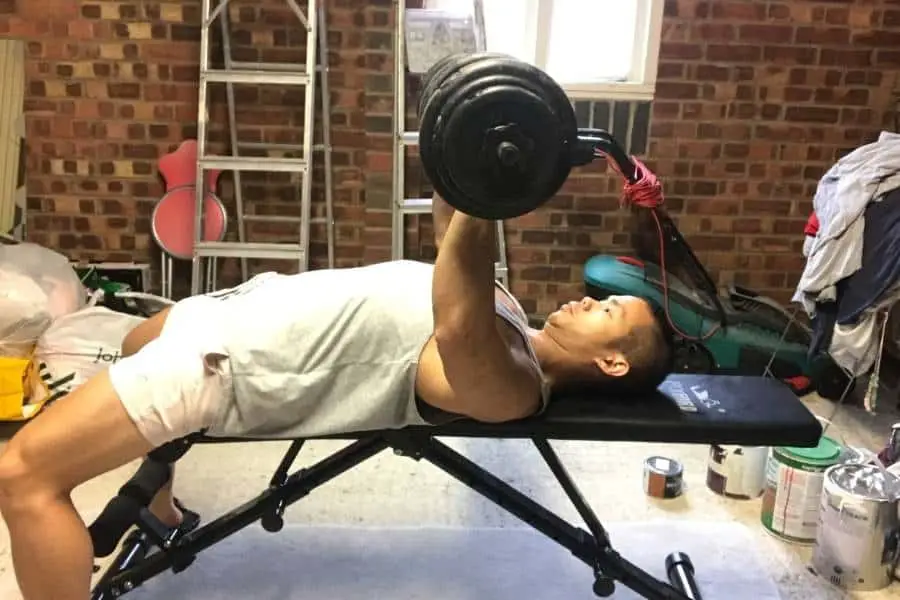
Mid-range benches like the Flybird (click here for the cheapest price) are affordable, foldable, and the flat/incline/decline settings can be used to train the entire body at home. I’ve been using it for 2 years now and can’t recommend it enough! You can check out my full Flybird analysis here.
- 1) A Stack Of Towels To Incline The Chest With No Bench
- 2) Use A Reclining Chair Instead Of An Incline Bench
- 3) Mimic An Incline Bench With Slanted Bed Slats
- 4) Edge Of A Kitchen Chair As An Incline Bench Alternative
- 5) Use A Foam Roller As An Incline Bench Press Alternative.
- 6) Decline Push-Ups As An Incline Bench Press Alternative
- 7) Do Band Presses To Incline Bench Press Without A Bench
- 8) Wide Grip Dumbbell Overhead Press For The Upper Chest
- 9) Dumbbell Pullovers Are Great For The Upper Chest
- 10) Dumbbell Flyes Are Perfect For DIY Incline Benches
- 11) Upward Dumbbell Fly To Isolate The Upper Chest
- Recommended Dumbbell
- Conclusion
1) A Stack Of Towels To Incline The Chest With No Bench
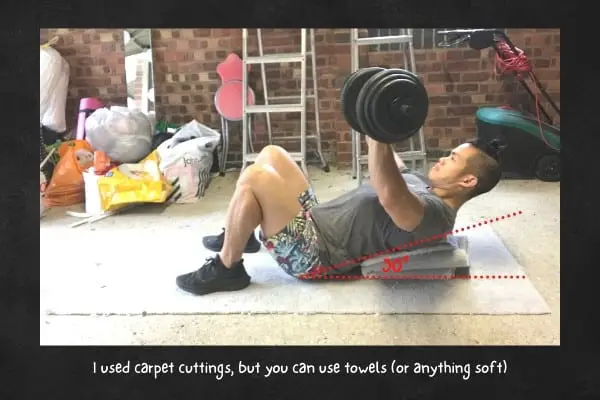
A stack of towels is an effective way to incline the chest without a bench. It requires 2 to 4 thick-woven bathroom towels to be folded and stacked against a wall. This allows the user to create a stable and comfortable incline angle in a cost-effective manner.
How to do it:
- Fold your towels into 1×1 foot square and stack the towels into a tower.
- Place the towel tower against a wall.
- Sit in front of the tower and lean backwards.
- Rest your upper back against the towels.
- Grab your dumbbells and incline press.
Top Tip:
This is one of the easiest incline bench alternatives to use, but it can be unstable.
Plant your feet and buttocks into the ground but arch your back. This will brace your body and stabilize it whilst you lift your dumbbells.
2) Use A Reclining Chair Instead Of An Incline Bench

A reclinable chair can be used instead of an incline bench. It requires a chair that can incline 60-30°. This creates a comfortable incline platform to bench press light dumbbells. The best chairs will have a backrest that is narrow enough to not restrict the arms as they move.
How to do it:
- Set the desired incline angle on your reclining chair.
- Lay down into the chair with dumbbells on your thighs.
- Bring the dumbbells into the incline bench press position (kick them up with your thighs if the angle is awkward).
- Slowly press the dumbbells upwards.
- Lower the dumbbells back down.
Top Tip:
Always check the weight capacity for the deck chair.
This will often be quite low, so make sure your weights aren’t too heavy. Lighter dumbbells performed at higher reps and a slow tempo are ideal for this incline bench alternative.
The last thing you want is for the chair to collapse whilst performing a heavy barbell incline press!
3) Mimic An Incline Bench With Slanted Bed Slats
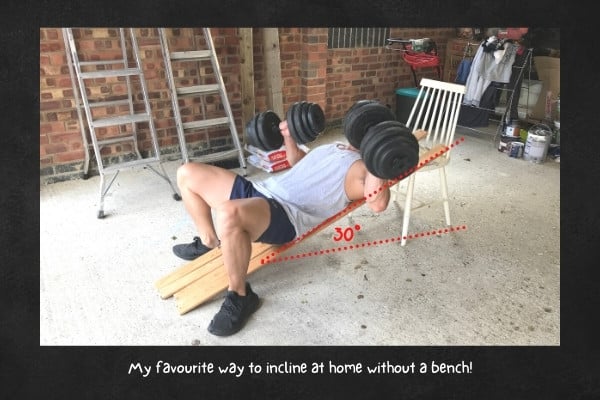
Bed slats can be used to mimic an incline bench at home. These can be combined with a kitchen chair to create a 30° inclined platform that can hold a lot of weight and is easy to set up. A yoga mat can also be laid on top for comfort.
How to do it:
- Lean one side of 4-bed slats against the edge of a kitchen chair with the other side laying on the ground.
- Lay your entire back on top of the homemade incline bench.
- Bend your knees and plant your feet into the ground for support.
- Bring your dumbbells into an incline bench press position.
- Slowly press the dumbbells up and down.
Top Tip:
This is one of my favorite incline bench alternatives because it’s so easy to set up and relatively safe (place pillows underneath the bed slats for extra safety).
Chairs with a lower seat height are better. Aim for a seat height that is under 2 feet. Not only does this allow your bed slats to create a ~30° incline which is optimal for upper chest activation, but it will also be sturdier.
For those trying to create their own DIY incline bench- it will help to know what dimensions to aim for. My other article reveals the average dimensions of a weight bench.
4) Edge Of A Kitchen Chair As An Incline Bench Alternative
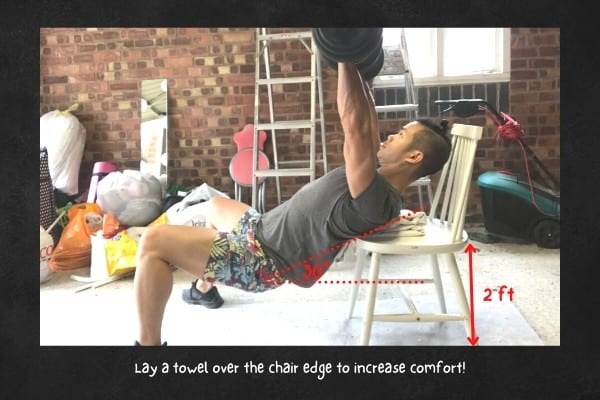
A kitchen chair can be used as an incline bench alternative at home. The front edge of the chair can be rested on to create a makeshift incline angle. A kitchen chair is readily available in all households, easy to use, and quick to set up.
How to do it:
- Sit on the floor in front of a kitchen chair.
- Rest your upper back on the front edge of the chair.
- Bend your knees and plant both feet into the ground whilst raising your hips off the floor. This will create a 30° incline angle.
- Bring your dumbbells into an incline press position.
- Begin slowly pressing your dumbbells up and down.
Top Tip:
A chair with a seat height of no more than 2 feet above the ground is ideal since the higher the seat, the harder it is to maintain the optimal 30° angle for an incline press.
Though cheap and easy to set up, this is also one of the more uncomfortable incline bench alternatives because the chair edge can dig into your back
Therefore using this method to do lighter dumbbells with higher reps is ideal. You can also place some towels or a yoga mat over the chair edge to improve comfort.
Yoga mats like the Balance Form can be delivered quickly and cheaply from Amazon.
5) Use A Foam Roller As An Incline Bench Press Alternative.
A foam roller makes an effective incline bench alternative. This requires the user to lay on a roll of foam or bubble wrap that is at least 6 inches thick. It’s a cheap, comfortable, and readily available method for those who do not have an incline bench.
How to do it:
- Place a foam roller on the ground
- Sit in front of the foam roller and lean backwards
- Rest your upper back into the foam roller. The roller should be positioned at the bottom of your shoulder blades.
- Bend your knees and plant your feet into the ground for stabiltiy.
- Bring the dumbbells into an incline bench press position.
- Slowly press your dumbbells up and down.
Top Tip:
If you don’t have a foam roller, you can use anything soft, compression-resistant, and has at least 6 inches of height.
A sack of rice, flour, or sand works as a great alternative. If you use this option, try wiggling your back into the sack to get a great contour and maximize comfort!
A rolled yoga mat (click here to see the one I use) also works great as a foam-roller alternative.
Check out my other article for even more home weight bench alternatives, including makeshift flat benches!
6) Decline Push-Ups As An Incline Bench Press Alternative

Decline push-ups are an effective bodyweight incline bench press alternative. The difficulty of decline push-ups can be increased by reducing the movement tempo to a 4-second downward and 2-second upward phase. This will increase upper pectoral time under tension and activation.
How to do it:
- Find a stable elevated platform that’s around 2 feet off the ground. A chair works great.
- Bring yourself to a push-up position with your feet placed on the elevated platform and your hands planted into the ground shoulder-width apart. The arms should be fully extended and the palms facing forwards.
- Slowly lower the front end of your torso towards the ground whilst keeping your chin up and facing forwards.
- Count for 4 seconds on the way down.
- Hold the position for a split second once your chin is an inch off the ground.
- Slowly press yourself back up.
- Count for 2 seconds on the way up.
Top Tip:
You can also wrap a resistance band around your upper back and arms to add even more resistance to the decline push-up. This makes the movement much more challenging compared to bodyweight alone.
As a result, you’ll further increase upper pectoral activation.
Alternatively, if you have some free weights lying about at home, you can try doing decline push-ups on dumbbells for an effective pec workout!
7) Do Band Presses To Incline Bench Press Without A Bench
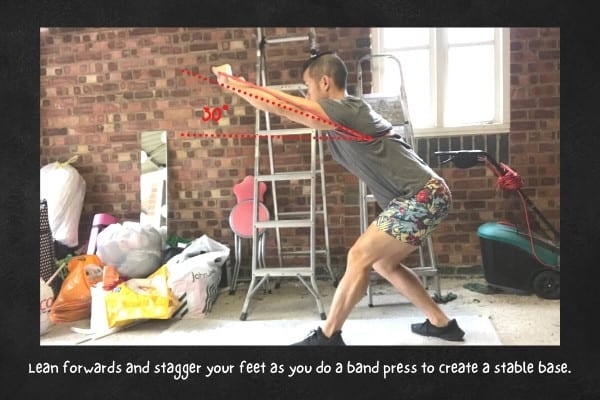
The standing incline band press is a good incline bench press alternative without a bench. Pressing a resistance band forwards at a 30° angle from the torso whilst standing will replicate the incline bench press movement and activate the upper chest.
How to do it:
- Secure a resistance band to the door using a door anchor or pin it to the ground by stepping on it with your rear foot.
- Stand with staggered feet at a shoulder-width distance apart. Staggered feet simply mean placing your dominant foot forward and weak foot rearward. Point the toes forwards and slightly outwards to create a stable base.
- Make a slight bend at the knees and keep your back straight.
- Hold each end of the band using a neutral grip (palms facing the body).
- Slowly press it forwards and upwards at a 30° angle.
- Bring both hands together as you push forwards maximally contract the upper pecs.
- Slowly return the hands back towards the torso.
Top Tip:
Staggering your feet will allow you to lean your torso forwards 10° as you press your bands.
Leaning forward is essential to increase stability because it reduces the need for your core muscles to counteract the elasticity of the bands. This allows you to press heavier bands and get a greater upper chest workout!
If you’re interested in buying some bands- be careful about the cheap budget models.
I’ve had 2 sets snap on me in the past (both within 1 year of use).

I’d recommend spending a bit more money to get the Undersun Bands (click here to check the cheapest price). These come with a lifetime warranty and are great for training the entire body (see James Grage’s Youtube channel for awesome workouts).
Also don’t forget gloves to protect your hands from friction burns. I found cheap ones like the Ihuans to be a cost-effective option that does the job perfectly well.
8) Wide Grip Dumbbell Overhead Press For The Upper Chest
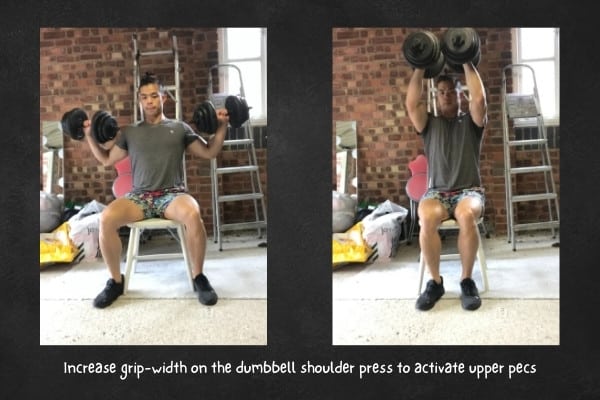
The dumbbell overhead press can be modified to target the upper chest. This involves pressing two dumbbells upwards with a wide grip and bringing the dumbbells together at the top. The top portion of the movement will activate the upper pectorals.
How to do it:
- Sit on a DIY weight bench or sturdy chair and keep your back upright at 90° from the floor.
- Hold a pair of dumbbells in line with each other at shoulder-level using an overhand grip (palms facing forwards).
- Slowly press the dumbbells upwards whilst keeping your back straight.
- Bring the dumbbells together and supinate the wrists (rotate them to face each other) as you reach the top of the movement.
- Hold this position for a second to isometrically contract the upper chest.
- Slowly lower the dumbbells back down to the wide starting position.
- Pronate the wrists (rotate them to face forwards) as you reach the starting position.
Top Tip:
Whilst this exercise can also be done standing, the seated variation will make it more difficult since it’s harder to use body momentum to help you press the dumbbells.
Additionally, you can actively squeeze the dumbbells together at the top of the movement (like you’re trying to squash them together). This will further increase upper chest activation.
9) Dumbbell Pullovers Are Great For The Upper Chest
The floor dumbbell pullover is a great way to activate the upper chest without a bench. It’s a versatile exercise that requires the back, arm, and chest muscles. The bottom portion of the movement requires strong activation from the upper pectorals.
How to do it:
- Lay your back on a flat surface. An elevated surface such as a DIY flat bench is best, but the floor also works well.
- Make a diamond shape with your hands by bringing your thumbs and index fingers together.
- Use the diamond-shaped formation to hold a single dumbbell by resting the flat surface of the weight on the flats of your palms. The dumbbell handle should run through the “hole” of the diamond.
- Hold the dumbbell above the head with your arms fully extended.
- Lower the dumbbell by arcing it down and behind your head. keep your arms straight at all times.
- Stop when the dumbbell comes in line with your head and torso.
- Slowly bring the dumbbell back over your head.
Top Tip:
Let the weight of the dumbbell rest on the flats of your palm and avoid actively gripping the dumbbell. When done properly, gravity will push the dumbbell into your hands and the diamond grip will prevent it from falling off your hands.
By not actively gripping the dumbbell, you minimize the influence of your arms to help lift the dumbbell during the upward phase of the movement. This focuses the contraction on your upper pecs.
This is an awesome chest exercise without a bench. But to get the most from it, you’ll need some heavy dumbbells.
10) Dumbbell Flyes Are Perfect For DIY Incline Benches
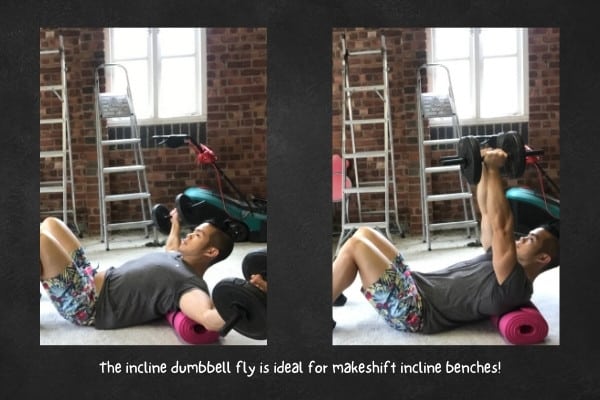
The incline dumbbell chest fly is a great exercise for DIY incline benches. Bringing two dumbbells together in a horizontal adduction movement will isolate the upper chest. The chest fly is safer to perform on a makeshift bench compared to a barbell incline press since dumbbells are lighter.
How to do it:
- Lay on your DIY incline bench and hold two dumbbells together in each hand.
- Extend your arms to bring the dumbbells above your chest.
- Lower the dumbbells by arcing your arms out and downwards.
- Stop when the elbows come in line with your torso.
- Bring the dumbbells back up by arcing your arms in and upwards.
- Squeeze the dumbbells together at the top of the movement.
Top Tip:
Maintain a 90-120° bend in both elbows to prevent your arms from fully locking straight and keep your arms like this throughout the motion.
This relieves stress on your shoulder joint whilst still being effective at engaging the upper pecs.
For more information on how to do chest flyes without a bench, check out my article here.
11) Upward Dumbbell Fly To Isolate The Upper Chest
The upward dumbbell fly is an effective way to isolate the upper chest without a bench. This involves bringing two dumbbells together in a horizontal adduction movement from a standing position. It’s a great alternative for those who don’t have an incline bench and don’t want to make one either.
How to do it:
- Stand holding two dumbbells in each hand using a neutral grip (palms facing the body and dumbbells running perpendicular to the torso’s horizontal plane).
- Lift both dumbbells upwards by arcing your arms up.
- Bring the dumbbells together as your arms arc upwards.
- Stop when the dumbbells reach the nipple-line and your arms run parallel to the ground.
- Hold the contraction for a second.
- Slowly return the dumbbells back to the starting position.
Top Tip:
Although it may be tempting, the dumbbells should not go above the nipple line. Once this happens, the exercise becomes more shoulder-dominant than chest-dominant.
Bending your knees will also help to brace your torso and limit the temptation to swing your body to help lift the dumbbells. This is cheating and won’t benefit chest development!
If you’re struggling to build a killer chest, you can check out my other post for reasons why your pecs aren’t growing.
Recommended Dumbbell
| Bench | Brand | Description | Prime | Buy |
|---|---|---|---|---|
Top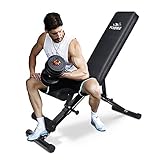 Top
Top
Top
Top
Top
Top Top
Top
Top
Top
Top
Top | Flybird | Fully-adjustable (flat/incline/decline) weight bench that can be folded for storage. Good for people 6'0 and over | PrimeEligible | Check Amazon Price |
 Top
Top
Top
Top
Top
Top Top
Top
Top
Top
Top
Top | Fitness Reality | Fully-adjustable (flat/incline/decline) weight bench that can be folded for storage. Good for people under 6'0 | PrimeEligible | Check Amazon Price |
 Top
Top
Top
Top
Top
Top
Top
Top | PowerBlock | BEST heavy adjustable dumbbell on the market. 5-90lbs (with addon kit) in 2.5lb increments make these great for building muscle and losing fat at home. Very durable. | PrimeEligible | Check Amazon Price |
 Top
Top
Top
Top
Top
Top
Top
Top | Yes4All | BUDGET alternative for a heavy adjustable dumbbell. Cheap and durable but fewer increments and slower adjustment speeds compared to the PowerBlocks | PrimeEligible | Check Amazon Price |
I talk a lot about dumbbell exercises in this article.
If you’re interested in buying a set for yourself, it’s important to choose the right ones.
Cheap dumbbells (like the ones you see me use in the first photo) not only have a tendency to malfunction, but their limited weight also means you may find yourself wasting money having to upgrade further down the line.
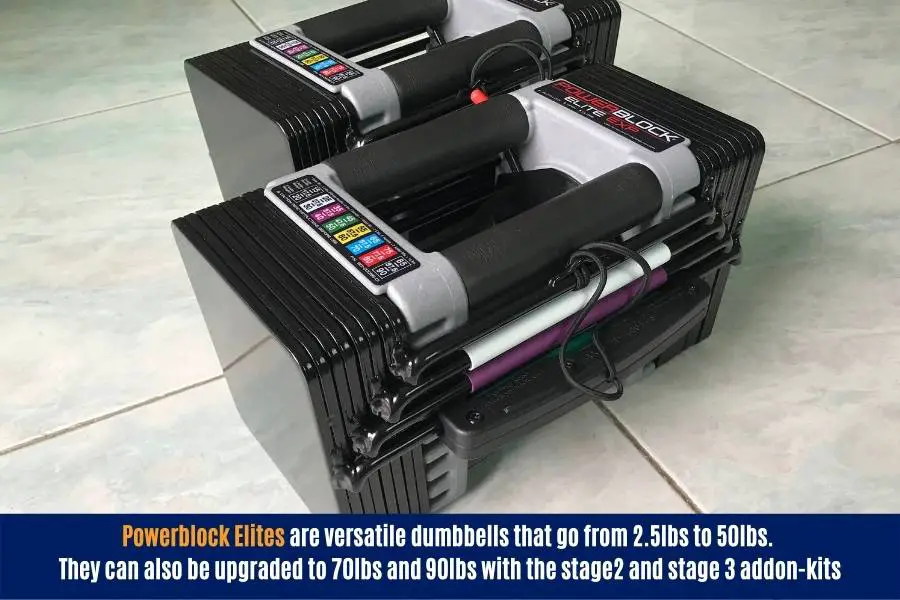
I use and recommend the Powerblock Elites.
They’re not exactly cheap, and the block shape can be awkward if you’re used to normal-shaped dumbbells. But they’ll last you for years (if not you’re entire training history).
You can find the cheapest price here.
They start at 2.5lbs per dumbbell and can be adjusted up to 90lbs (with 2.5lb/5lb increments). This makes them great for light isolation-type exercises as well as heavy compound lifting.
The best thing about them?
They start at 50lbs per dumbbell but can be upgraded to 70lbs and 90lbs using the stage 2 and stage 3 addon kits whenever you wish.
This means you don’t have to fork out hundreds of bucks from the get-go. Instead, you can upgrade the weight whenever you’re ready.
I use them to train my entire body conveniently at home. They work very well with the incline bench ideas detailed in this article.
Conclusion
These are my favorite home incline bench alternatives anyone can try for a ripped upper chest.
Furthermore, I’ve included both incline weight bench alternatives, as well as incline bench press exercise alternatives.
As you can see, there are many crafty ways to train the upper pecs without having to buy an incline bench.
That being said, I would always recommend those who regularly train the chest, consider buying a folding adjustable bench.
Mid-range benches like the Flybird (see reviews here) can be found for very reasonable prices, and the folding capabilities are ideal for when space is tight.
And a proper bench is always much safer than a DIY bench!
Which incline bench alternatives will you be trying?
Let me know in the comments!
You may also be interested in the downloadable Kalibre Blueprint PDF which details exactly how I gained 40lbs of lean muscle (it’s 100% free!). It gives the exact exercises and nutrition I used to go from skinny to ripped!
Thanks for reading guys!
Peace Out,
Kal
(Biochemistry BSc, Biomedical Sciences MSc, Ex-Skinny Guy)


